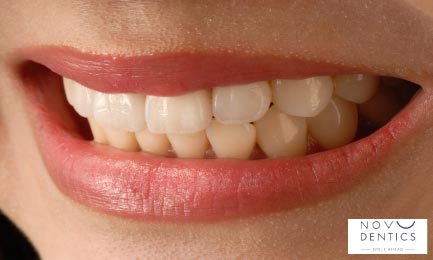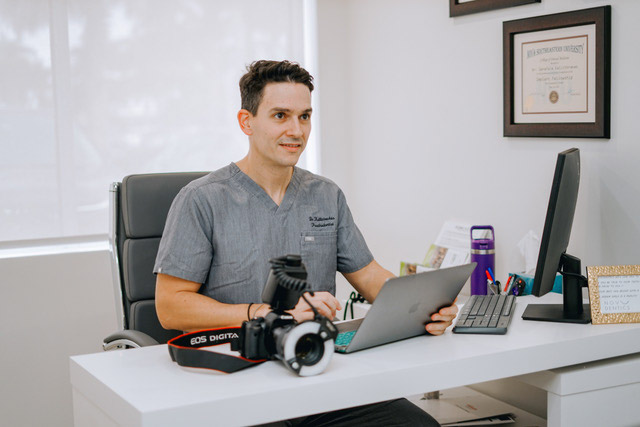Porcelain veneers are one of the most popular and effective cosmetic dentistry treatments available today. These thin shells bonded to the front surface of teeth can completely rejuvenate your smile by hiding flaws, improving color, and correcting minor alignment issues. At Novudentics in Palm Beach, we are intimately familiar with veneers of all types.
Simply put, veneers provide patients with dramatic, transformative results that can boost self-confidence. Crafted from durable dental porcelain, veneers mimic the natural translucency of real teeth and can last over a decade with proper care. In this comprehensive guide, we’ll explain everything you need to know about porcelain veneers – what they are, types of materials used, benefits and uses, costs, procedure steps, and how long they last. With their immediate, smile-enhancing outcomes, it’s no wonder porcelain veneers have become a go-to solution for enhancing the appearance of your teeth quickly and predictably.
What Are Porcelain Veneers?
Porcelain veneers are an indirect dental restoration that is used to improve the appearance of the anterior teeth mainly. Patients who have complaints about the size, shape or shade of their teeth are a prime candidate for these types of dental veneers.

Veneers are an effective cosmetic solution for improving the appearance of your smile by masking discolored, chipped, crooked or gapped teeth. They are usually made from feldspathic porcelain which is a highly translucent and esthetic material that can perfectly mimic your natural teeth anatomy and texture.
Indirect vs Direct Dental Restorations Explained
I mentioned the term indirect dental restoration earlier, and I want to take time to explain this. An indirect dental restoration is a type of dental restoration that is fabricated outside of the mouth by a dental technician, and then later bonded/cemented into place by the dentist. Common examples of indirect dental restorations include: dental crowns, bridges, and veneers.
A direct dental restoration is a restoration that is placed directly into the mouth and bonded to the tooth during the same dental visit. Common examples of direct dental restorations include: fillings, sealants, and bonding.
Are There Advantages to Porcelain Dental Veneers?
Porcelain veneers are long lasting and color stable. If done by a Prosthodontist, they can last more than 20 years. Their biggest advantage is the minimal preparation of the tooth that preserves its vitality and most of its volume.
The right diagnosis from an experienced restorative dentist has to be placed before the patient is presented this option due to the limitations this procedure presents with.
When is it Time to Get Porcelain Veneers?
If you experience misaligned, discolored and uneven teeth, you should consider getting some veneers that will restore these abnormalities and boost your morale. The fabrication of porcelain veneers is a technique sensitive procedure and consultation with your Prosthodontist is highly recommended.
Possible limitations or contraindications include deep overbite, lack of posterior support or completely misaligned teeth that require orthodontic movement before the restorative procedures.
Challenges of Veneers
Two aspects of the treatment with veneers could pose some unexpected issues for the dentist; first, fabricating temporary restorations that the patient use as a “test drive” before proceeding to the final restoration and second the cementation of the final restoration that could be a challenging task since it has to happen under very good isolation and through a technique called bonding.
Bonding, in dental terms, refers to the process of adhering dental material to the surface of a tooth using dental adhesives.
What Should I Expect From the Porcelain Veneers Procedure?
At Novudentics, we use the latest technology so we can provide you with the best result in terms of function and esthetics.

First, we listen to your chief complaint, and we work diligently to address it. We use a digital scanner to make a 3D impression of your existing dentition and we plan the optimal smile through a digital technique called virtual mockup.
Afterwards, we fabricate a PMMA (polymethyl methacrylate) shell which will be our test drive, or blueprint, before the final restoration.
The day of the preparatory procedure of the teeth, we isolate, prepare and impress the teeth before delivering the temporary restoration. After local anesthetic is administered, we grind minimally the anterior surface of the tooth, and we replace it with a very thin porcelain restoration.
The case is sent to our lab for the fabrication of the final restoration, and you go home with a new smile!
How Long Do Porcelain Veneers Last?
With proper oral care, porcelain and ceramic veneers can last 10-15 years or longer before replacement is needed. Resin veneers have a shorter lifespan of 5-7 years. Factors that impact longevity include:
- Adhering to good oral hygiene and regular dental cleanings/exams. This prevents decay and other damage under veneers.
- Avoiding tooth grinding habits or using a night guard to prevent excessive wear.
- The skill of the cosmetic dentist placing the veneers. A proper bond and fit is key.
- Being cautious to avoid fracture from trauma. Veneers can chip or crack from impacts.
Are Porcelain Veneers Painful?
Patients typically experience only minimal sensitivity or discomfort from veneers. Your dentist will use anesthesia to numb the teeth during the tooth reduction step, making the preparation process comfortable. Some temporary sensitivity to hot and cold is normal afterward as the teeth adjust and heal. Stronger pain medications are rarely needed.
Can Veneers Go Over Crowns or Fillings?
Porcelain and ceramic veneers can generally be placed over top of dental crowns or fillings on front teeth. Since veneers don’t require much enamel removal, they can overlay existing dental work to refresh your smile.
Do Veneers Ruin Your Teeth?
Veneers don’t damage the internal structures of your tooth. Removing some enamel is necessary for the veneers to sit flush on your teeth, but this process is mild and non-irreversible. With proper oral hygiene, your natural teeth will remain healthy with veneers.
However, it is a semi-permanent procedure. Reverting back to your natural unenhanced smile would require having the veneers removed. This is a simpler process than having them initially placed.
Are There Alternatives to Dental Veneers?
Popular alternatives to veneers include:
- Teeth Whitening – Whitening strips, gels or dental treatments remove stains for a brighter smile. Whitening alone may not fix shape or alignment issues.
- Dental Bonding – Composite resin material is applied to the teeth and hardened with light. Offers a short-term fix for chips, gaps or discoloration.
- Dental Crowns – Crowns are a longer-lasting solution for damaged or decayed teeth. However, crowns require more tooth reduction than veneers.
- Orthodontic Treatment – Braces and retainers help straighten crooked teeth and close gaps. A longer process than veneers.
Are Veneers Safe?
Porcelain veneers are a great option for the right case. That is why a diagnosis from a prosthodontist is necessary in order to provide a long-lasting result that will satisfy you completely.
Get a Veneer Consultation Today
Schedule an appointment with us at Novudentics to to determine which veneer option is best for your particular case. This is based on your goals, teeth condition, time frame and budget. With their transformative effects and lasting results, porcelain veneers are one of the most popular and effective cosmetic dental treatments available today.

